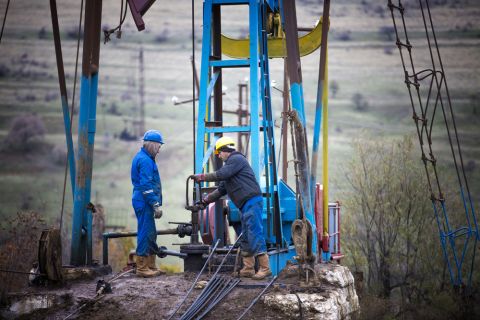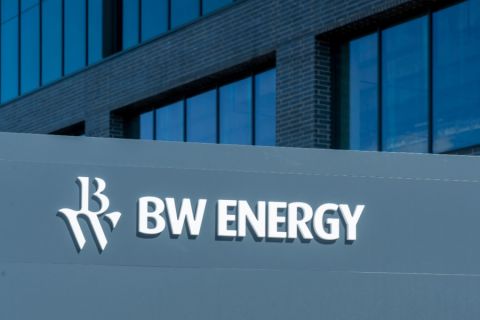Private-equity funds are helping seasoned E&P management teams repeat earlier upstream successes under new banners. With billions of private-equity dollars pouring into the upstream energy space today from many institutions, the managers of those funds are looking, more than ever, for private start-ups with teams that know how to replicate past successes. In short, "we're looking for E&P teams with a good track record of creating value," says one Dallas-based private-equity fund manager. Ideally, those teams should not only know a play type well, but have grown production, reserves and cash flows in that type of play before or have the skill sets necessary to replicate that growth in similar play types elsewhere. One other fund manager emphasizes that it isn't necessary that an operator have assets in a hot play like the Barnett Shale in the Fort Worth Basin or an inventory of tight-sands gas prospects in Colorado's Piceance Basin. While Shakespeare's Hamlet may have thought "the play's the thing," he doesn't. "More than the play or the commodity, we focus on three things: management, management and management-particularly those teams that are experienced and creative." The common theme among the managements of these private E&P companies: they've all "been there and done that" when it comes to successfully growing start-ups from scratch. And, while their holdings may be diverse, their strategies are very similar and very in step with what their private-equity backers are seeking in an upstream investment. Balanced approach Formed in April 2004, Tulsa's Avalon Oil & Gas Inc. is no stranger to harvesting hydrocarbons in south-central Oklahoma. That's because this private operator's management team is largely comprised of veteran hole-punchers who kick-started Avalon Exploration. That private predecessor grew from a zero asset base in 1983 to a point in 2000 where it sold off the majority of its Oklahoma oil and gas holdings for more than $100 million. Three years later, after a foray into exploration drilling in Russia, the Avalon Exploration group, headed by John Wieczorek and Randy Sullivan, returned to its Oklahoma roots. It then approached Dallas-based Energy Spectrum Capital LP and its affiliate Energy Trust Partners LP, which makes private-equity investments in the upstream. "We showed Energy Trust two initial focus areas, primarily in south-central Oklahoma-the Wichita Mountain Front region and the West Edmond Hunton Lime Unit (Wehlu)," says Bob Davis, an Avalon Oil & Gas vice president and partner. The former play contains deep-gas exploration targets in the 17,000- to 19,000-foot Springer formation, with output potential of more than 40 billion cubic feet (Bcf) per well, Davis says. The Wehlu holding is a 10,000-acre farm-out contributed by Avalon Exploration; in 2003, that unit had five wells producing from the 7,000- to 8,000-foot Hunton formation. The Wehlu is essentially a development-drilling play that provides Avalon with the cash flow to fund its exploration growth in the Wichita Mountain Front region, and in the Woods County area in north-central Oklahoma where it is focused on the 5,500-foot Mississippian Limestone play, says Avalon Oil & Gas partner Sullivan. "You might say, looking at our 20-plus years of experience in Oklahoma, that Avalon Oil & Gas is the same song, second verse of Avalon Exploration," adds Wieczorek, the company's president and a seasoned structural geologist and geophysicist. "We're essentially still swinging for the fences, looking for company-maker home runs in the Wichita Mountain Front while building the cash-flow strength of the company through more conservative development drilling in the Wehlu," he explains. It's a balanced approach that interested Energy Trust, which in April 2004 provided the Avalon partners with an initial $10 million of private-equity funding. With that funding, plus a revolving credit facility with Banc First of Oklahoma, Avalon Oil & Gas was able, through late 2005, to increase the number of producing wells in the Wehlu from five to 16, boosting average daily output per well to 200 barrels of oil and 250,000 cubic feet of gas. The result: major gains in cash flow and reserves. Between November 2003 and November 2005, the company overall grew from losing $50,000 per month in EBITDA (earnings before interest, taxes, depreciation and amortization) to achieving a positive $1.3 million per month in EBITDA, adds Scott Swaim, Avalon chief financial officer. Meanwhile, the PV-9 value of its reserves jumped from around $8 million to more than $48 million as those reserves mushroomed from 460,000 gross barrels of oil and 1.8 Bcf of gas to 2.15 million barrels and 5 Bcf. In that time, the company was also able to triple Wehlu production through the use of downhole submersible pumps, which permit more oil and gas to flow into the 16 wellbores at faster rates, says Joe Preece, Avalon senior geologist. Swaim adds that Avalon Oil & Gas plans to drill 14 wells at a gross cost of $35 million this year; comparatively, the producer spent $7.2 million in 2005 to drill about 10 wells. One of these 2006 wells will be a 19,000-foot exploratory test near Burns Flat in the Wichita Mountain Front area, over which the company has recently acquired extensive 3-D seismic and high-graded its existing 2-D seismic data base. Says Wieczorek, "We're looking at the possibility of 40-plus Bcf per well there." Sidney Tassin, president of Energy Spectrum Capital in Dallas-a capital provider that through its Energy Trust affiliate has invested about $100 million of private equity in the E&P sector since 2001-says Avalon had the three ingredients his firm seeks when making an upstream investment. "The company had a management team with a good track record of creating value, an existing asset base with reserves and reserve potential, and identified additional areas for further exploration and development growth." Energy Spectrum Capital, which also invests in the midstream sector, this past April closed its new $300-million Energy Trust II LP fund aimed at future E&P opportunities. Complete team Begun in January 1995, Dallas-based Rising Star Energy LLC is a private E&P company originally formed by three officers of Placid Oil Co. on the heels of the latter's 1994 sale to Occidental Petroleum Corp. During the next five years, Mike Grimm, president and chief executive of Rising Star, made sure the company lived up to its name. By April 2000, the start-up was able to grow its West Texas Permian Basin output to the point where it sold the majority of its producing assets, which, on a daily basis, then consisted of 20 million cubic feet of gas, 2,000 barrels of oil and about 2,500 barrels of gas liquids. But Grimm, former vice president of worldwide exploration and land for Placid, still liked the long-lived reserve/production ratios in the Permian, acquiring production there and elsewhere, and using 3-D seismic data acquisition and interpretation to find added upside. "We've always been prospect generators and very focused on drilling wildcat wells in large stratigraphic plays where there's lots of repeatability, then mitigating risk by selling off interests in those prospects," explains Grimm. "So we decided, with the remaining assets we had in Rising Star, to grow the company." That's when it approached Ken Hersh, managing director of Natural Gas Partners, an Irving, Texas-based provider of private-equity capital managed by NGP Energy Capital Management. The capital provider since 1988 has invested $3 billion-plus in more than 85 E&P, midstream and oil-service companies. Its most recent private-equity fund, Natural Gas Partners VIII LP, closed this past November with a total of $1.3 billion of investment commitments. "What we liked about Rising Star was that it had assembled one of the most complete, experienced and creative management teams we had ever seen," says Hersh. "Its team covered virtually every oil and gas discipline, plus it was equally adept at acquisitions, exploration, development and exploitation." In July 2001, NGP committed up to $35 million in private equity to Rising Star, which then had 2 million cubic feet of daily gas production. With this backing, the operator that fall acquired an interest in the Esperson Dome Field in South Texas for $2.5 million, which boosted its daily gas production by 1 million cubic feet per day. Then, in July 2002, the company bought for $25 million all the E&P assets of DDD Energy, a subsidiary of Houston-based seismic company Seitel Inc. "Through this transaction, we added another 7 million cubic feet of daily gas production and 500 barrels of daily oil output from DDD's assets in the Texas/Louisiana Gulf Coast, California and Michigan," says Grimm. Moreover, Rising Star obtained a license to more than 2,000 square miles of 3-D seismic data, mainly covering the Texas/Louisiana Gulf Coast Tertiary. After ramping up its geophysical efforts, Rising Star began working that seismic database, looking for fault blocks that hadn't been drilled. This ultimately led to the drilling of 10 deep wells in the 14,000-foot Yegua Trend in Southeast Texas and nine more wells in the large Hosston-Cotton Valley stratigraphic play in North Louisiana, at depths ranging from 9,500 to 14,000 feet. In addition, in late 2002, the company jointly acquired interests in La ReForma Field in South Texas from Merit Energy. Daily output there at the time was about 2 million gross cubic feet equivalent, notes Grimm. "But after merging and reprocessing existing 3-D seismic data on the field, we were able to drill 15 wells to the 7,000- to 12,000-foot Vicksburg formation during the past 18 months and increase daily gas production there to 25 million gross cubic feet equivalent." Adds the explorationist, "Since the time we received funding from Natural Gas Partners in 2001-when our daily Permian Basin output was around 2 million cubic feet-our companywide production has grown 10-fold. Meanwhile, monthly cash flow has risen from upwards of $400,000 to more than $4 million." In 2006, the company plans to drill or participate in drilling between 60 and 80 wells with a capex budget of $70 million-about double last year's activity and spending. Technologically savvy When J. Ross Craft, president of Approach Resources Inc., formed his private Fort Worth-based company in late 2002-with the help of an initial $30-million commitment from Yorktown Partners-the acquisition market for tight-sands gas properties in the West Texas Permian Basin was expensive and risky. So Approach took another approach. "We began looking for farm-outs that we could drill our way into," explains Craft. That took a little while, but in January 2004, the right opportunity came along when J. Cleo Thompson, a successful Dallas oil and gas man, gave Approach the chance to pick up a 70% interest in a 48,000-acre block of contiguous leases in West Texas in the 8,000-foot Canyon gas play in Crockett and Schleicher counties. The price of entry? The operator did a 3-D seismic shoot over the play, which cost $1.4 million, and entered into a 20-well drilling commitment costing an additional $10 million. Approach Resources, whose core team had been together since 1988 and had been previously backed by Yorktown in another start-up, knew the Canyon play well. In the early 1990s, in association with American Cometra, it acquired interests in a similar play in the region for $23 million, then sold those interests for $180 million four years later. "With statistical volumetrics modeling, we determined that under the 48,000-acre Canyon gas play there was as much as 800 Bcf of original gas in place, which had hardly been tapped, and that reserves per well were 750 million cubic feet," says Craft. With the help of Jim Scott, a seasoned geologist with Approach who understands the sequencing of the Canyon play's subsea, fluvial sand deposits, the company began its development-drilling program there in mid-2004. It also introduced to the farm-out a new completion technology: CO2 foam fracs. "The traditional approach to completing tight-sands wells has been to use a gel/water frac, but that type of frac often tends to overcome formation pressure and create water-blockage problems in the fracturing system," explains Craft. "With CO2 foam, you eliminate water blockage in the frac system, plus the CO2 actually brings back more of the frac fluids from the treated formation, resulting in better well clean-up. That, in turn, allows production from treated wells to come online quicker and at much higher flow rates." The benefits of statistical volumetric modeling, 3-D seismic analysis and new completion technology: 19 months ago, when Approach began drilling the Canyon gas play, it had zero production. Today, after drilling and completing 168 wells, daily gross output from the farm-out stands at 42.7 million cubic feet equivalent, 28 million of that net to the company. Meanwhile, proved reserves, also zero at the outset of drilling, are now 125 billion cubic feet equivalent and, when probable and possible reserves are included, full net reserve realization is expected to be 268 billion equivalent. "Currently, we've identified 811 well locations on the farm-out that remain to be drilled, and between 2006 and 2008 we expect to spend $104 million per year to drill up the majority of those wells, increasing production at a compound annual growth rate of 35%," says Craft. The funding for this growth will come not only from Yorktown Partners, and also Frost Bank in Fort Worth and JP Morgan Chase, which have increased the operator's revolver to $45 million, and from internally generated cash flow. Approach's EBITDAX (earnings before interest, taxes, depreciation, amortization and exploration expenses), which was $5 million at year-end 2004, is projected to grow to $117 million in 2006. M
Recommended Reading
PropFlow Names David Ward as CEO
2024-05-13 - As CEO, David Ward will lead and build out PropFlow’s operations of eliminating debris from proppant at well sites in the Permian Basin and other plays.
Dividends Declared in the Week of May 6
2024-05-10 - Here is a selection of upstream, midstream and service and supply companies’ dividends declared in the past week.
OFS Sector Loses Jobs, but Trade Org Says Growth Potential Remains
2024-05-08 - According to analysis by the Energy Workforce & Technology Council, the OFS job market may still have potential for growth despite a slight decrease in the sector in April.
Exxon Appoints Maria Jelescu Dreyfus to Board
2024-05-08 - Dreyfus is CEO and founder of Ardinall Investment Management, a sustainable investment firm, and currently serves on the board of Cadiz Inc. and Canada-based pension fund CDPQ.
E&P BW Energy Undergoes ‘Technical’ Ownership Restructuring
2024-05-08 - The restructuring will not involve any change to the ultimate control of BW Energy as the shares currently held by BW Group will be sold to BW Energy Holdings.





